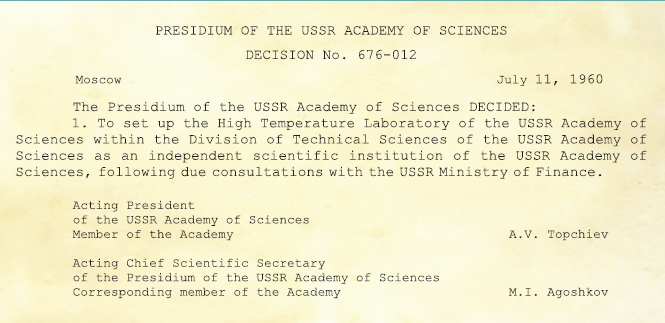
The history of the Joint Institute for High Temperatures of the Russian Academy of Sciences begins in 1960, the year when the High Temperature Laboratory of the USSR Academy of Sciences was set up. During fifty years that passed since that time, the Institute grew up from a small research laboratory at the Moscow Institute of Power Engineering into a major institution of the Division of Energetics, Mechanical Engineering, Mechanics, and Control Systems of the Russian Academy of Sciences – the leading scientific center of the country in the field of power generation and thermophysics (including the region of high energy densities). The very idea of setting up the High Temperature Laboratory originated because the research in the field of thermophysical properties and heat transfer, which was carried out at the Chair of Engineering Thermophysics, was in so high a demand by the nuclear and rocket tech nologies rapidly developing at the time and the scale of this research was so much higher than the regular scale of research performed at an educational institution or even at the Problem Oriented Laboratory that the urgent need for a fullscale research institute became obvious.
 The High Temperature Laboratory of the USSR Academy of Sciences was set up on July 11, 1960 by decision of the Presidium of the USSR Academy of Sciences, with V.A. Kirillin, Corresponding Member of the USSR Academy of Sciences as its director. Very soon after that, at the very beginning of 1961, Prof. Kirillin was replaced by Prof.
The High Temperature Laboratory of the USSR Academy of Sciences was set up on July 11, 1960 by decision of the Presidium of the USSR Academy of Sciences, with V.A. Kirillin, Corresponding Member of the USSR Academy of Sciences as its director. Very soon after that, at the very beginning of 1961, Prof. Kirillin was replaced by Prof.
A.E. Sheindlin. In 1962, the Research Institute for High Temperatures at the Moscow Institute of Power Engineering was set up by decree of the USSR Government on the basis of the Problem Oriented Laboratory at the Chair of Engineering Thermophysics and the High Temperature Laboratory of the USSR Academy of Sciences.
By this time, activities were already under way at the High Temperature Laboratory
of the USSR Academy of Sciences in totally new spheres, namely, low temperature plasma research and MHD heat-to-electric energy conversion. Because of the basic character of this research, the Research Institute for High Temperatures at the Moscow Institute of Power Engineering was transferred under the authority of the USSR Academy of Sciences. As a result of this transfer, the Institute was renamed to Institute for High Temperatures
of the USSR Academy of Sciences (IVTAN). A.E. Sheindlin (who by that time became a Corresponding Member of the USSR Academy of Sciences) was appointed its director and served in this capacity for well over 20 years.
During this period, IVTAN turned into a major scientific center of the USSR withproving grounds, branches, and divisions performing studies into new spheres of power generation. Unique test beds and facilities were developed under scientific guidance of A.E. Sheindlin, basic research was carried out, and important results were obtained, which provided the scientific basis for a number of most advanced technologies. In the first stage of MHD-related activities, the physical principles of operation of open-cycle MHD generators were successfully developed and demonstrated using laboratory test beds. Parallel activities were started, which were related to the physics of low-temperature plasma, superconducting magnet systems, high-temperature materials, and other spheres of importance from the standpoint of development of MHD generators.
The next stage involved the development and construction of the U-02 model power-generating facility which contained prototypes of basic elements of the future MHD power plant. The U-02 Facility was commissioned in 1964 on the premises of one of the oldest power plants (TETs-2) in the very center of Moscow. An important stage in the development of MHD-related activities was that associated with the design and construction of the U-25 pilot facility. A special design bureau for novel equipment was set up at the USSR Ministry of Energy for designing the MHD generator (this design bureau was later transferred to IVTAN). The construction site for the U-25 Facility was selected in the neighborhood of TETs-21 (central heating and power plant) of Mosenergo (Moscow City power grid). This location helped solve the problems associated with power supply of the U-25 Facility and with transmission of electrical power generated at the U-25 Facility to the Moscow power grid. The actual construction of the facility involved serious difficulties because the area was previously taken up by swamp and dumping ground. Simultaneously with the beginning of construction of U-25, the principal research divisions of IVTAN began to be moved over to this site. During this period, the Experimental Production Shop for making unique equipment was added to the special design bureau for novel equipment of IVTAN. The U-25 Facility was commissioned in 1971. By this time, the Institute had close to 4000 people on the staff, and its production infrastructure extended beyond the traditional academic framework. The results of investigations performed in the U-02 and U-25 Facilities made it possible to start the activities on the project of the MHD-500 first commercial-scale MHD power-generating unit with a power of 500 MW. The Ryazan central power plant was selected as the site for the construction of MHD-500. The contractor design for MHD-500 was completed, and the construction of the main buildings was started. The steam-turbine unit was constructed and successfully commissioned. As to the manufacture and assembly of MHD equipment, this work was first stopped for a number of reasons and then completely discontinued. Nevertheless, the scientific results of these activities are of permanent ignificance:
they gave rise to a large number of associated technologies which found application in numerous fields.
The MHD research at JIHT involved studies into the electrophysical and thermophysical properties of low-temperature plasma for quite a wide range of materials. The interaction between moving plasma and magnetic field was investigated, and structures were developed which are capable of operation at high temperatures in the presence of electric current and magnetic fields.

Numerous lines of new equipment were developed such as MHD channels, combustors, nozzles, diffusers, steam generators, magnet systems including superconducting ones, and so on, which were tested in model and experimental facilities.
The activities related to MHD research were developing very rapidly; they were well
financed, and received close attention of "decision-taking" bodies. The Institute was visited by Chairman of the USSR Council of Ministers A.N. Kosygin, Vice-Chairman of the USSR Council of Ministers Academician V.A. Kirillin, USSR Minister of Energy P.S. Neporozhnii, residents of the USSR Academy of Sciences M.V. Keldysh and A.P. Aleksandrov, Academicians E.P. Velikhov, V.A. Kotel'nikov, A.A. Mikulin, and many others.
In 1986, in response to the call of the leadership of the Academy of Sciences for
rejuvenating the corps of directors, A.E. Sheindlin was the first in the Academy to apply for retirement from the post of director. By special decision of the Academy's Division for Physicotechnical Problems in Energy, A.E. Sheindlin was appointed Honorary Director of JIHT RAS (and is still serving in this capacity)
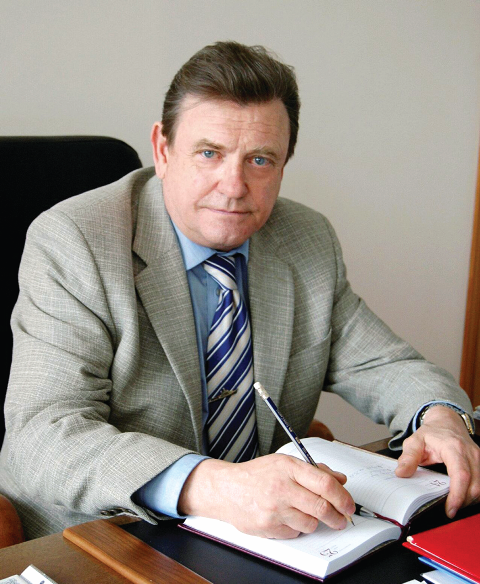 In 1987, V.M. Batenin, Corresponding Member of the Russian Academy of Sciences, became the Director of the Institute. The profound changes in the political and economic situation in the country in the early 1990s could not but make an impact on the Institute life and activities. Younger people, technical specialists, and qualified workers started leaving the Institute. Some of the first-rate
In 1987, V.M. Batenin, Corresponding Member of the Russian Academy of Sciences, became the Director of the Institute. The profound changes in the political and economic situation in the country in the early 1990s could not but make an impact on the Institute life and activities. Younger people, technical specialists, and qualified workers started leaving the Institute. Some of the first-rate
scientists went abroad. It was difficult to maintain the production and experimental activities on a full scale. Nevertheless, the Institute by and large stood up to these difficulties (although the vast and technically complex infrastructure called for enormous expenses and large human resource) and retained its position of the largest institute in its Division of the Academy and one of the largest institutes in the Academy as a whole. And the credit for this must be given to V.M. Batenin, whose term as director fell on this dramatic period in the life of the Institute.

At this "difficult" time of the 1990s, many people tend to believe that smaller organizations given certain financial-and-economic independence may be capable of better adapting themselves to new conditions. Eight such structures formed in the Institute; they existed under one roof which was first referred to as IVTAN Scientific Association and later as Joint Institute for High Temperatures of the Russian Academy of Sciences. However, life showed that it was not everybody that benefited from such independence; the number of such structures was gradually reduced and, as a result, the system of Joint Institute retained Institute for High Temperatures proper, Institute of High Energy Densities, Institute of Theoretical and Applied Electrodynamics, Research Center of Energy Conservation Processes and Facilities, Engineering-and-Operation Complex, and Research Station in Frunze (now Bishkek, Kyrgyzstan).
The Institute came to be managed by a collective body, namely, the Board of Directors; in 1999, A.N. Lagar'kov, Corresponding Member of the Russian Academy of Sciences, became the Chairman of this Board and remained at this post until 2007. He made an appreciable contribution to saving and augmenting the scientific and technical potential and prestige of the Institute.

By the end of 2006, the prevailing situation, including the changes in the normative-and-legal sphere, caused the need for yet another decision concerning structural transformations. As a result, the Research Station in Bishkek and the Institute of Theoretical and Applied Electrodynamics left JIHT RAS in 2005 and at the end of 2006, respectively, and became entirely independent, though friendly, structures; the remaining constituent parts of JIHT merged into a single entity while retaining some degree of autonomy.
As was already mentioned, V.E. Fortov, Member of the Russian Academy of Sciences, became the director of this new JIHT RAS (at the same time, he continues in his capacity as the Secretary of the Division of Energetics, Mechanical Engineering, Mechanics, and Control Systems of the Russian Academy of Sciences).
 The High Temperature Laboratory of the USSR Academy of Sciences was set up on July 11, 1960 by decision of the Presidium of the USSR Academy of Sciences, with V.A. Kirillin, Corresponding Member of the USSR Academy of Sciences as its director. Very soon after that, at the very beginning of 1961, Prof. Kirillin was replaced by Prof.
The High Temperature Laboratory of the USSR Academy of Sciences was set up on July 11, 1960 by decision of the Presidium of the USSR Academy of Sciences, with V.A. Kirillin, Corresponding Member of the USSR Academy of Sciences as its director. Very soon after that, at the very beginning of 1961, Prof. Kirillin was replaced by Prof.

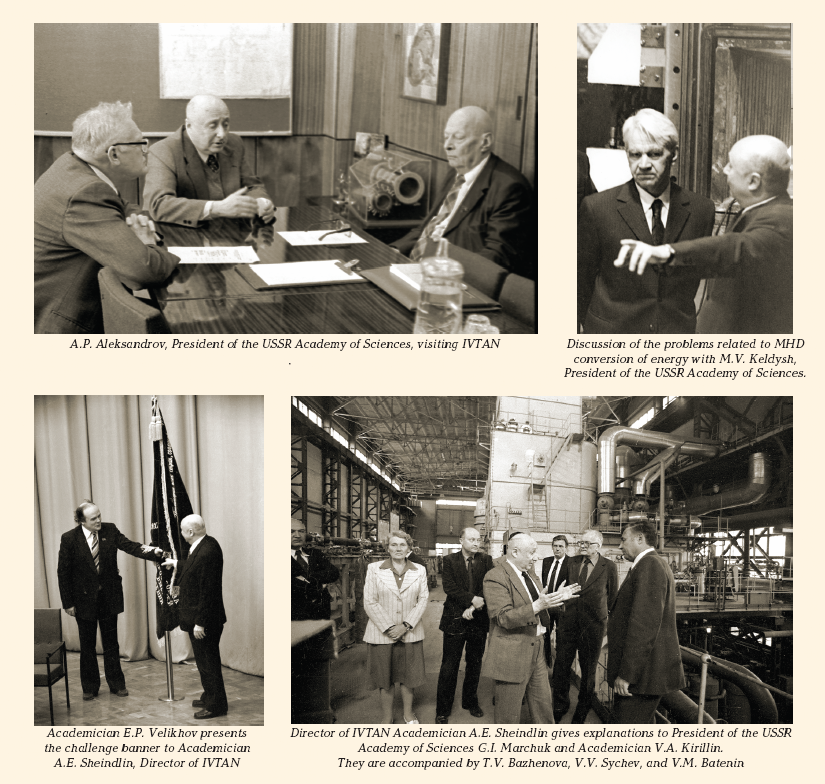
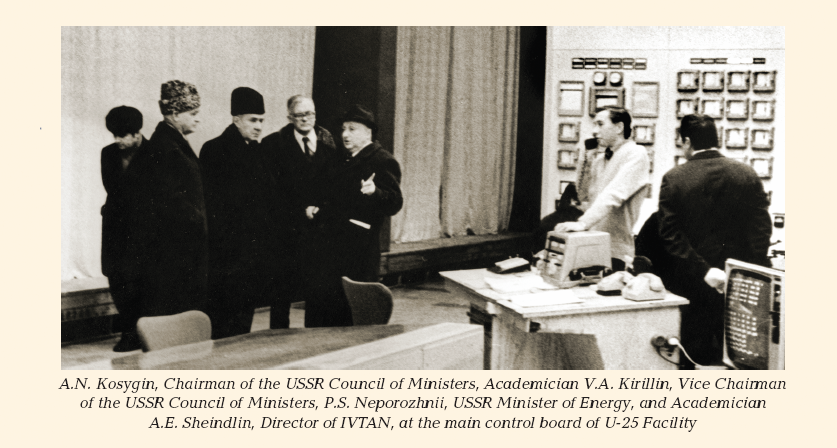
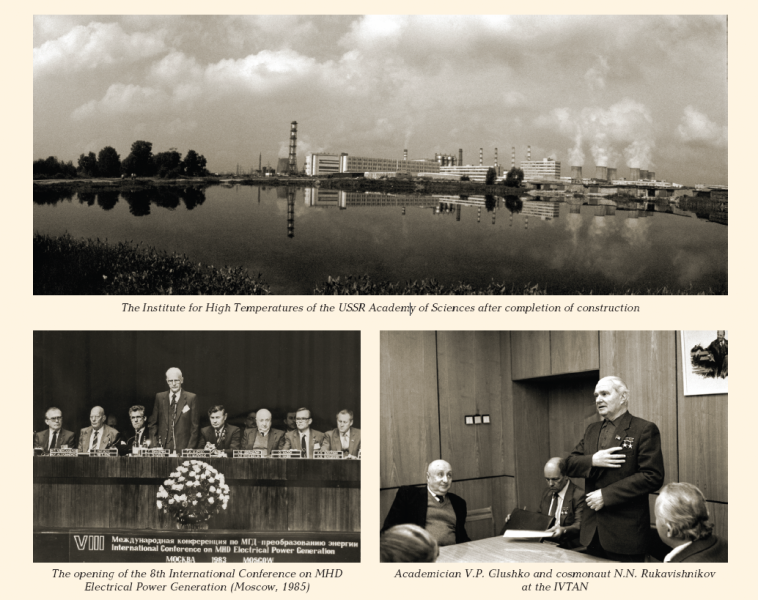
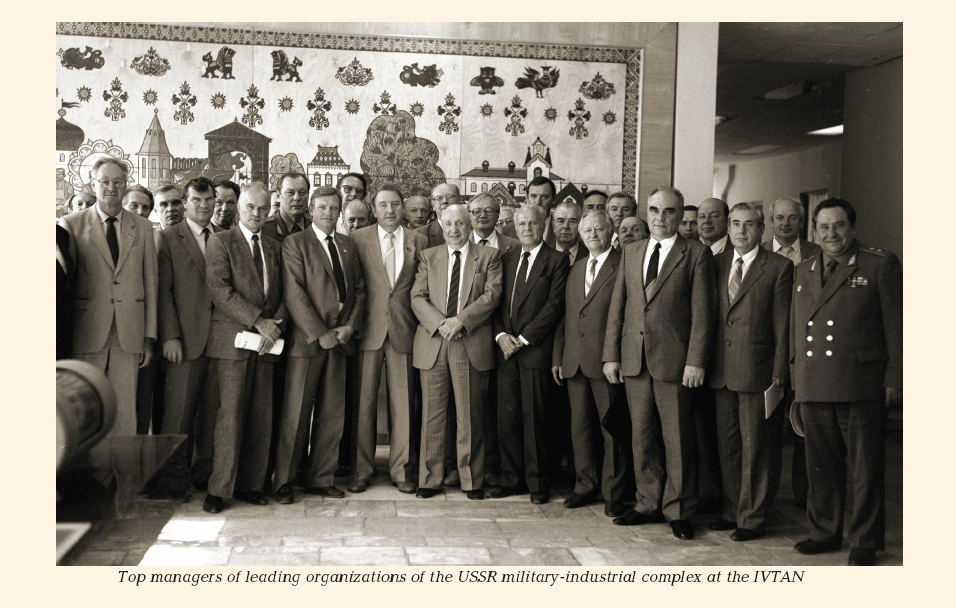
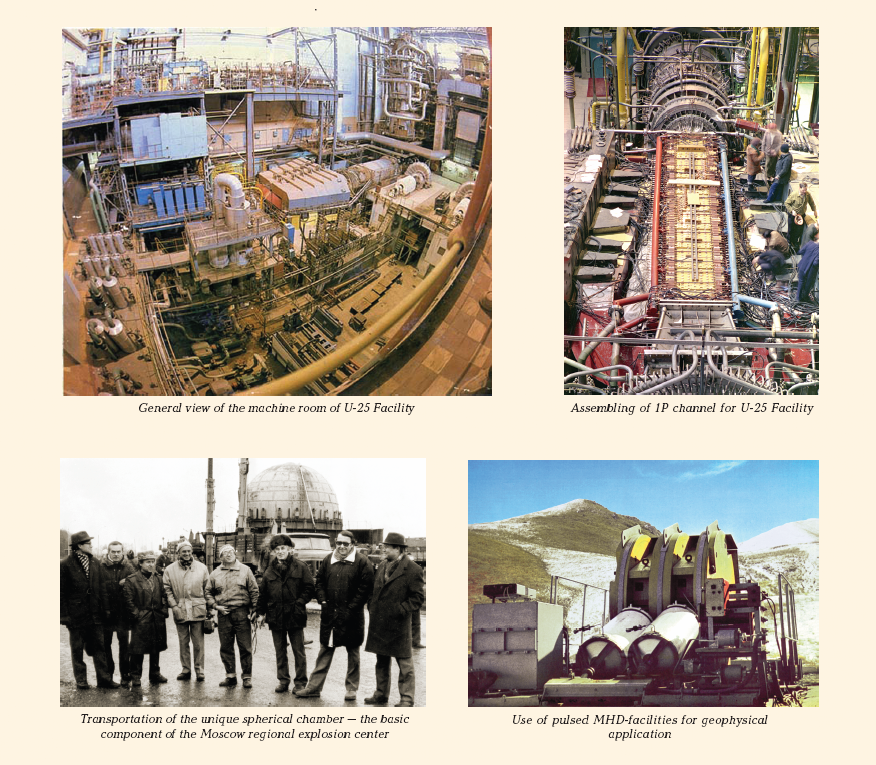
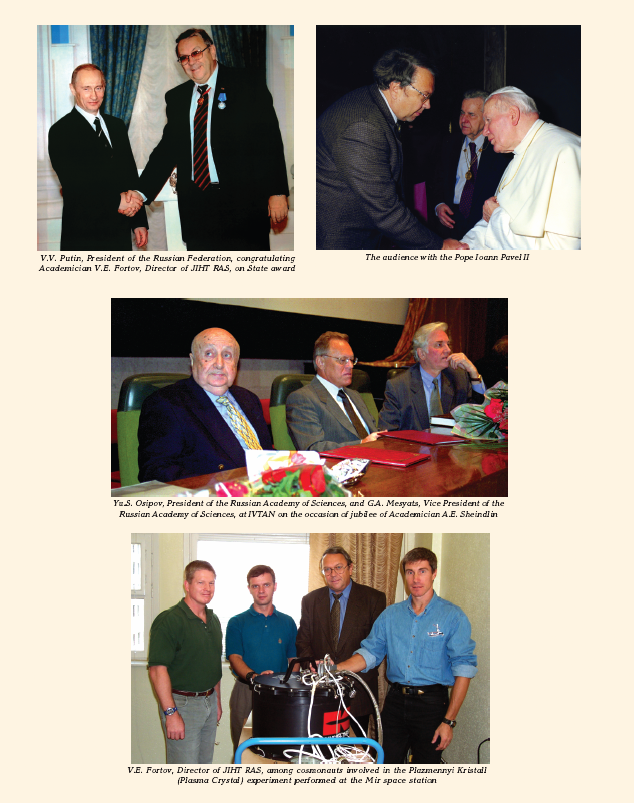





 In 1987, V.M. Batenin, Corresponding Member of the Russian Academy of Sciences, became the Director of the Institute. The profound changes in the political and economic situation in the country in the early 1990s could not but make an impact on the Institute life and activities. Younger people, technical specialists, and qualified workers started leaving the Institute. Some of the first-rate
In 1987, V.M. Batenin, Corresponding Member of the Russian Academy of Sciences, became the Director of the Institute. The profound changes in the political and economic situation in the country in the early 1990s could not but make an impact on the Institute life and activities. Younger people, technical specialists, and qualified workers started leaving the Institute. Some of the first-rate

